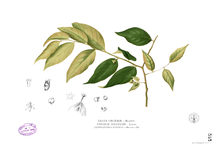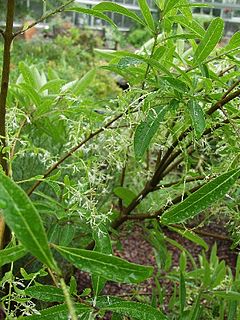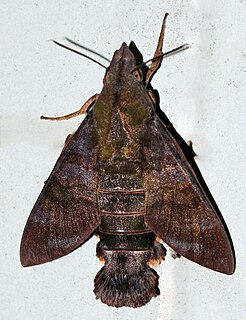| Cleistanthus | |
|---|---|
 | |
| Cleistanthus orgyialis [1] | |
| Scientific classification | |
| Kingdom: | Plantae |
| Clade: | Tracheophytes |
| Clade: | Angiosperms |
| Clade: | Eudicots |
| Clade: | Rosids |
| Order: | Malpighiales |
| Family: | Phyllanthaceae |
| Subfamily: | Phyllanthoideae |
| Tribe: | Bridelieae |
| Subtribe: | Pseudolachnostylidinae |
| Genus: | Cleistanthus Hook.f. ex Planch. |
| Synonyms [2] | |

Cleistanthus is a plant genus of the family Phyllanthaceae, tribe Bridelieae, first described as a genus in 1848. [3] [4] It is widespread in much of the Old World Tropics in Asia, Africa, Australia, and various oceanic islands. [2] [5] [6] Cleistanthus collinus is known for being toxic and may be the agent of homicides or suicides. [7]
- Species [2]
- Cleistanthus acuminatus – Sri Lanka
- Cleistanthus andamanicus – Andaman Islands
- Cleistanthus angustifolius – Luzon
- Cleistanthus annamensis – Vietnam
- Cleistanthus apodus – Queensland, eastern New Guinea
- Cleistanthus bakonensis – Borneo
- Cleistanthus balakrishnanii – Nicobar Islands
- Cleistanthus bambidianus – Gabon
- Cleistanthus baramicus – Borneo
- Cleistanthus beccarianus – Sarawak
- Cleistanthus bipindensis – Central Africa
- Cleistanthus boivinianus – Madagascar
- Cleistanthus bracteosus – Peninsular Malaysia
- Cleistanthus bracteosus – Indonesia, Philippines
- Cleistanthus capuronii – eastern Madagascar
- Cleistanthus carolinianus – Palau
- Cleistanthus caudatus – Central Africa
- Cleistanthus celebicus – Sabah, Sulawesi
- Cleistanthus chlorocarpus – Sarawak
- Cleistanthus collinus – Indian Subcontinent
- Cleistanthus concinnus – Hainan, Vietnam
- Cleistanthus contractus – Peninsular Malaysia, Sabah
- Cleistanthus coriaceus – Sarawak
- Cleistanthus cunninghamii – Queensland, New South Wales
- Cleistanthus curtisii – Peninsular Malaysia
- Cleistanthus dallachyanus – Queensland, Northern Territory
- Cleistanthus decurrens – Thailand, Philippines, Borneo, Peninsular Malaysia
- Cleistanthus denudatus – Thailand
- Cleistanthus discolor – Queensland
- † Cleistanthus diversifolius – ?
- Cleistanthus dolichophyllus – Peninsular Malaysia
- Cleistanthus duvipermaniorum – Democratic Republic of the Congo, Angola
- Cleistanthus eberhardtii – Vietnam
- Cleistanthus ellipticus – Peninsular Malaysia
- Cleistanthus elongatus – Sarawak
- Cleistanthus erycibifolius – Peninsular Malaysia, Borneo, Negros
- Cleistanthus everettii – Borneo, Philippines
- Cleistanthus evrardii – Democratic Republic of the Congo, Republic of the Congo
- Cleistanthus ferrugineus – Sri Lanka
- Cleistanthus flavescens – Peninsular Malaysia
- Cleistanthus floricola – Flores
- Cleistanthus gabonensis – Gabon
- Cleistanthus glaber – Borneo, Peninsular Malaysia, Mindanao
- Cleistanthus glabratus – Sarawak
- Cleistanthus glandulosus – Peninsular Malaysia, southern Thailand, Sumatra
- Cleistanthus gracilis – Peninsular Malaysia, southern Thailand, Sumatra, Borneo
- Cleistanthus helferi – Peninsular Malaysia, Thailand, Myanmar
- Cleistanthus hirsutopetalus – Peninsular Malaysia, Thailand, Singapore
- Cleistanthus hirsutulus – Peninsular Malaysia, Thailand, Sumatra, Borneo, Vietnam
- Cleistanthus hylandii – Queensland
- Cleistanthus indochinensis – Vietnam
- Cleistanthus inglorius – Papua New Guinea
- Cleistanthus insignis – Morobe
- Cleistanthus insularis – Palau
- Cleistanthus inundatus – Democratic Republic of the Congo, Republic of the Congo, Angola
- Cleistanthus isabellinus – Sabah, Philippines, New Guinea
- Cleistanthus itsoghensis – Central Africa
- Cleistanthus jacobsianus – Sarawak
- Cleistanthus kingii – Peninsular Malaysia
- Cleistanthus kwangensis – Democratic Republic of the Congo, Angola
- Cleistanthus langkawiensis – Langkawi
- Cleistanthus lanuginosus – Peninsular Malaysia
- Cleistanthus letouzeyi – Cameroon, Gabon, Equatorial Guinea
- Cleistanthus libericus – Western and Central Africa
- Cleistanthus longinervis – Peninsular Malaysia
- Cleistanthus macrophyllus – Peninsular Malaysia, southern Thailand, Borneo, Yunnan
- Cleistanthus maingayi – Peninsular Malaysia, Sarawak
- Cleistanthus major – Peninsular Malaysia
- Cleistanthus malabaricus – southwestern India
- Cleistanthus malaccensis – Peninsular Malaysia
- Cleistanthus meeboldii – Myanmar
- Cleistanthus megacarpus – Philippines, Indonesia
- Cleistanthus membranaceus – Peninsular Malaysia
- Cleistanthus micranthus – Fiji
- Cleistanthus monoicus – Guangdong
- Cleistanthus morii – Chuuk
- Cleistanthus namatanaiensis – Bismarck Archipelago
- Cleistanthus ngounyensis – Gabon
- Cleistanthus nitidus – Peninsular Malaysia
- Cleistanthus normanbyanus – D'Entrecasteaux Islands
- Cleistanthus oblongatus – Sarawak
- Cleistanthus oblongifolius – Bangladesh, Southeast Asia, Papuasia, Queensland
- Cleistanthus occidentalis – western Madagascar
- Cleistanthus pallidus – Sri Lanka
- Cleistanthus papuanus – Papua New Guinea
- Cleistanthus papyraceus – Myanmar, Thailand
- Cleistanthus parvifolius – Peninsular Malaysia
- Cleistanthus patulus – India, Sri Lanka
- Cleistanthus paxii – Sarawak
- Cleistanthus pedicellatus – Guangxi, Peninsular Malaysia, Borneo, Philippines, New Guinea
- Cleistanthus peninsularis – Papua New Guinea, Queensland
- Cleistanthus perrieri – eastern Madagascar
- Cleistanthus petelotii – Guangxi, Vietnam
- Cleistanthus pierlotii – Democratic Republic of the Congo, Gabon
- Cleistanthus pierrei – Vietnam
- Cleistanthus pilosus – Basilan, Mindanao
- Cleistanthus podocarpus – Peninsular Malaysia
- Cleistanthus podopyxis – Borneo
- Cleistanthus polyneurus – Peninsular Malaysia
- Cleistanthus polyphyllus – Peninsular Malaysia, southern Thailand
- Cleistanthus polystachyus – tropical Africa
- Cleistanthus praetermissus – Peninsular Malaysia, southern Thailand, Borneo
- Cleistanthus pseudopallidus – Sumatra
- Cleistanthus pseudopodocarpus – Peninsular Malaysia, Sumatra, Borneo
- Cleistanthus pubens – Borneo
- Cleistanthus pyrrhocarpus – Borneo
- Cleistanthus ripicola – tropical Africa
- Cleistanthus robinsonii – Palawan, Sibuyan
- Cleistanthus robustus – Sri Lanka, Andaman Islands
- Cleistanthus rotundatus – Cambodia
- Cleistanthus rufescens – Peninsular Malaysia, Sumatra, Borneo, Philippines
- Cleistanthus rufus – Peninsular Malaysia, southern Thailand
- Cleistanthus salicifolius – Sarawak
- Cleistanthus sankunnianus – southwestern India
- Cleistanthus sarawakensis – Sarawak
- Cleistanthus schlechteri – from Kenya to KwaZulu-Natal
- Cleistanthus semiopacus – Queensland
- Cleistanthus stenonia – Mayotte, Madagascar
- Cleistanthus stenophyllus – Myanmar
- Cleistanthus stipitatus – New Caledonia
- Cleistanthus stipularis – western India
- Cleistanthus striatus – Borneo
- Cleistanthus suarezensis – Madagascar
- Cleistanthus sumatranus – southern China, Southeast Asia, New Guinea
- Cleistanthus tenerifolius – Sumatra, Kalimantan
- Cleistanthus tomentosus – southern China, Southeast Asia
- Cleistanthus tonkinensis – southern China, Vietnam
- Cleistanthus travancorensis – southwestern India
- Cleistanthus venosus – Peninsular Malaysia, Sumatra, Borneo, Mindanao
- Cleistanthus vestitus – Peninsular Malaysia, Sumatra, Borneo, Luzon
- Cleistanthus winkleri – Borneo
- Cleistanthus xanthopus – Papua New Guinea
- Cleistanthus xerophilus – Queensland
- Cleistanthus zenkeri – tropical Africa

















